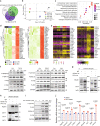PEAR1 regulates expansion of activated fibroblasts and deposition of extracellular matrix in pulmonary fibrosis
- PMID: 36402779
- PMCID: PMC9675736
- DOI: 10.1038/s41467-022-34870-w
PEAR1 regulates expansion of activated fibroblasts and deposition of extracellular matrix in pulmonary fibrosis
Erratum in
-
Author Correction: PEAR1 regulates expansion of activated fibroblasts and deposition of extracellular matrix in pulmonary fibrosis.Nat Commun. 2022 Dec 14;13(1):7749. doi: 10.1038/s41467-022-35543-4. Nat Commun. 2022. PMID: 36517493 Free PMC article. No abstract available.
Abstract
Pulmonary fibrosis is a chronic interstitial lung disease that causes irreversible and progressive lung scarring and respiratory failure. Activation of fibroblasts plays a central role in the progression of pulmonary fibrosis. Here we show that platelet endothelial aggregation receptor 1 (PEAR1) in fibroblasts may serve as a target for pulmonary fibrosis therapy. Pear1 deficiency in aged mice spontaneously causes alveolar collagens accumulation. Mesenchyme-specific Pear1 deficiency aggravates bleomycin-induced pulmonary fibrosis, confirming that PEAR1 potentially modulates pulmonary fibrosis progression via regulation of mesenchymal cell function. Moreover, single cell and bulk tissue RNA-seq analysis of pulmonary fibroblast reveals the expansion of Activated-fibroblast cluster and enrichment of marker genes in extracellular matrix development in Pear1-/- fibrotic lungs. We further show that PEAR1 associates with Protein Phosphatase 1 to suppress fibrotic factors-induced intracellular signalling and fibroblast activation. Intratracheal aerosolization of monoclonal antibodies activating PEAR1 greatly ameliorates pulmonary fibrosis in both WT and Pear1-humanized mice, significantly improving their survival rate.
© 2022. The Author(s).
Conflict of interest statement
The authors have submitted a patent application (application numbers PCT/CN2021/073547, CN202011212639.8) based on the results reported in this study. And the authors declare no other competing interests.
Figures




References
Publication types
MeSH terms
Substances
Grants and funding
LinkOut - more resources
Full Text Sources
Other Literature Sources
Medical
Molecular Biology Databases

